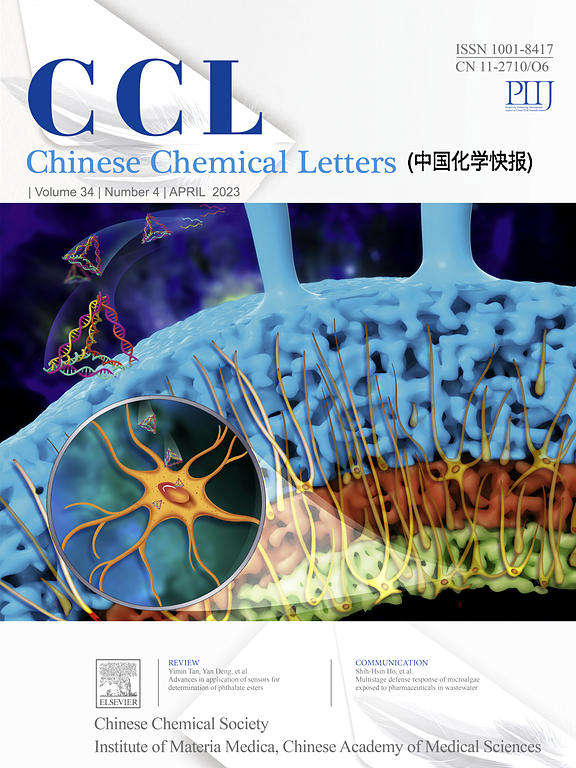结合两性离子水凝胶和ph响应微胶囊的正畸矫治器防晶生物膜智能防污涂层
IF 8.9
1区 化学
Q1 CHEMISTRY, MULTIDISCIPLINARY
引用次数: 0
摘要
矫治器具是矫正牙面畸形所必需的。然而,正畸器具无意中增加了细菌定植和牙结石形成的风险,这可能导致龋齿和牙龈炎。本研究将两性离子水凝胶(ZH)与包封杀菌剂的ph响应型微胶囊(PRMs)结合,开发了一种ph响应型防污涂层,在正畸矫治器中具有良好的抗菌和防结石协同作用。优异的防污性能可归因于以下两点:ZH通过静电诱导水化层提供抗粘附性能,而PRMs可以在酸性条件下通过按需释放杀菌剂来杀死细菌。结果表明,ZH+PRMs涂层在保持良好生物相容性的同时,显著降低细菌粘附,抑制结石形成。通过优化人口、难民和移民事务局浓度(0-15 wt %),与ZH型相比,古银的抗菌效率+人口、难民和移民事务局(最优浓度10 wt %)从49.8±7.3 % %增加到95.2±1.1 % %的大肠杆菌和85.7±3.5 % % % 1.4±91.3 %对变异链球菌。与原始钢(SS)相比,ZH+PRMs涂层的碳酸钙和磷酸钙分别降低了97.0% %和87.3% %。在体外模型中,与SS相比,我们的涂层将晶体生物膜的抑制作用从一天延长到五天。因此,本研究可以为降低正畸治疗中龋齿和牙龈炎的风险提供有希望的策略。本文章由计算机程序翻译,如有差异,请以英文原文为准。

Smart antifouling coating integrating zwitterionic hydrogel with pH-responsive microcapsules for anti-crystal biofilm of orthodontic appliances
Orthodontic appliances are essential for dentofacial deformity corrections. However, orthodontic appliances inadvertently increase the risk of bacterial colonization and dental calculus formation, which may lead to dental caries and gingivitis. Herein, this study developed a pH-responsive antifouling coating by integrating a zwitterionic hydrogel (ZH) with pH-responsive microcapsules (PRMs) encapsulating bactericide, displaying excellent synergies of anti-bacteria and anti-calculus for orthodontic appliances. The excellent antifouling properties can be attributed to two following points: ZH provides anti-adhesion properties via electrostatically induced hydration layers, while the PRMs can kill bacteria by on-demand bactericide release under acidic conditions. Results demonstrated that ZH+PRMs coating significantly reduced bacterial adhesion and inhibited calculus formation while maintaining excellent biocompatibility. By optimizing PRMs concentrations (0–15 wt%), compared with ZH, the antibacterial efficiency of ZH+PRMs (optimal concentration 10 wt%) increased from 49.8 % ± 7.3 % to 95.2 % ± 1.1 % for E. coli and from 85.7 % ± 3.5 % to 91.3 % ± 1.4 % for S. mutans. Compared with pristine steel (SS), ZH+PRMs coating showed ca. 97.0 % reduction for calcium carbonate and ca. 87.3 % reduction for calcium phosphate. In an in vitro model, compared with SS, our coating extended the crystal biofilm inhibition effect from one day to five days. Therefore, this study can provide promising strategies for reducing the risk of dental caries and gingivitis during orthodontic treatment.
求助全文
通过发布文献求助,成功后即可免费获取论文全文。
去求助
来源期刊

Chinese Chemical Letters
化学-化学综合
CiteScore
14.10
自引率
15.40%
发文量
8969
审稿时长
1.6 months
期刊介绍:
Chinese Chemical Letters (CCL) (ISSN 1001-8417) was founded in July 1990. The journal publishes preliminary accounts in the whole field of chemistry, including inorganic chemistry, organic chemistry, analytical chemistry, physical chemistry, polymer chemistry, applied chemistry, etc.Chinese Chemical Letters does not accept articles previously published or scheduled to be published. To verify originality, your article may be checked by the originality detection service CrossCheck.
 求助内容:
求助内容: 应助结果提醒方式:
应助结果提醒方式:


